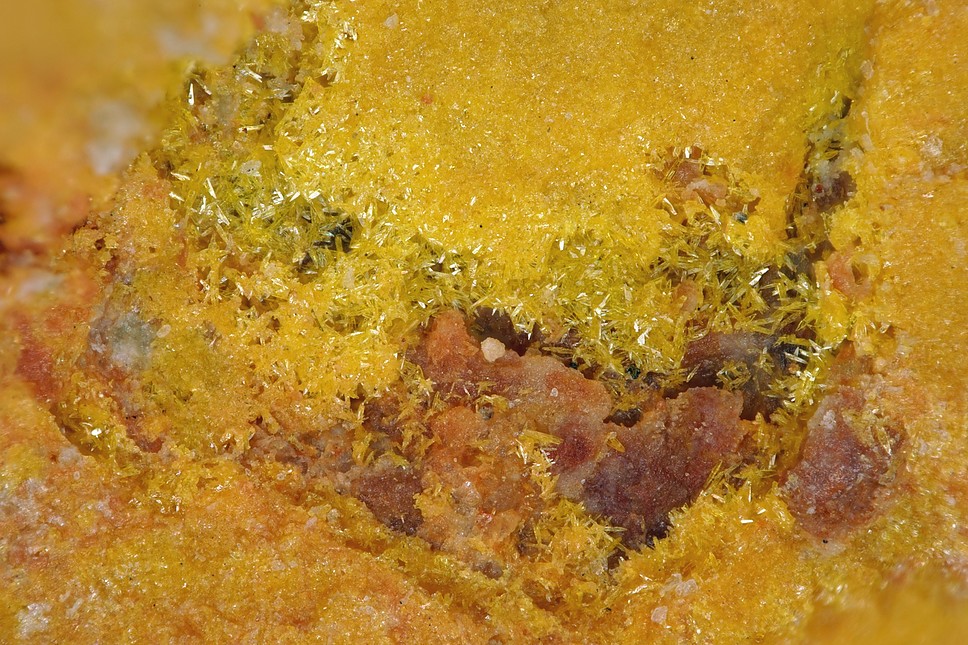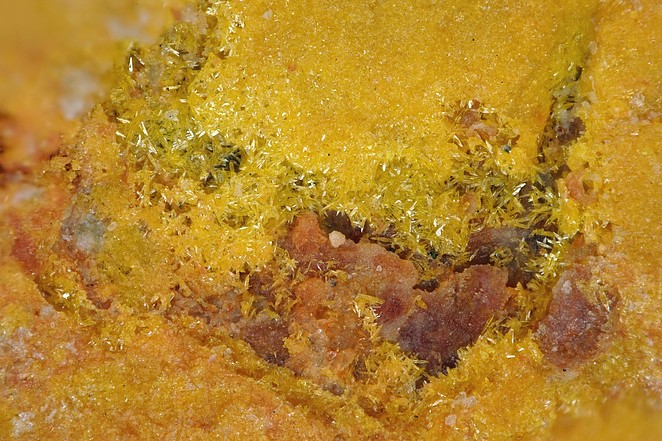Baumoite
A valid IMA mineral species
This page is currently not sponsored. Click here to sponsor this page.
About Baumoite
Formula:
BaU3Mo2O16(H2O)6
Colour:
Yellow to orange yellow
Lustre:
Vitreous
Hardness:
2½
Specific Gravity:
4.61 (Calculated)
Crystal System:
Monoclinic
Name:
Named for the composition that includes Ba, U, and Mo (barium, uranium and molybdenum).
New structure type. Unique combination of elements.
Typical features of the structure are twinning and incommensurate modulation. The structure is based on sheets of U6+ and Mo6+-bearing polyhedra, the topology of which is unique. Ba atoms are located in partially occupied sites in the interlayer space, where also water molecules occur.
Typical features of the structure are twinning and incommensurate modulation. The structure is based on sheets of U6+ and Mo6+-bearing polyhedra, the topology of which is unique. Ba atoms are located in partially occupied sites in the interlayer space, where also water molecules occur.
Unique Identifiers
Mindat ID:
52162
Long-form identifier:
mindat:1:1:52162:4
GUID
(UUID V4):
(UUID V4):
c8bc8b97-e3e6-4cc8-9d7a-1ef171665c9a
IMA Classification of Baumoite
Approved
IMA Formula:
Ba0.5[(UO2)3O8Mo2(OH)3](H2O)3
Approval year:
2017
First published:
2019
Classification of Baumoite
7.G0.
7 : SULFATES (selenates, tellurates, chromates, molybdates, wolframates)
G : Molybdates, Wolframates and Niobates
0 :
7 : SULFATES (selenates, tellurates, chromates, molybdates, wolframates)
G : Molybdates, Wolframates and Niobates
0 :
Mineral Symbols
As of 2021 there are now IMA–CNMNC approved mineral symbols (abbreviations) for each mineral species, useful for tables and diagrams.
| Symbol | Source | Reference |
|---|---|---|
| Bam | IMA–CNMNC | Warr, L.N. (2021). IMA–CNMNC approved mineral symbols. Mineralogical Magazine, 85(3), 291-320. doi:10.1180/mgm.2021.43 |
Physical Properties of Baumoite
Vitreous
Transparency:
Translucent
Colour:
Yellow to orange yellow
Streak:
Pale yellow
Hardness:
2½ on Mohs scale
Comment:
close to
Tenacity:
Brittle
Cleavage:
Perfect
one direction
one direction
Fracture:
Irregular/Uneven
Density:
4.61 g/cm3 (Calculated)
Comment:
4.61 g/cm3 from the empirical formula and 4.68 g/cm3 from the ideal formula
Optical Data of Baumoite
Type:
Biaxial (-)
RI values:
nα = 1.716(4) nβ = 1.761(4) nγ = 1.767(4)
2V:
Calculated: 42.2°
Max Birefringence:
δ = 0.051

Image shows birefringence interference colour range (at 30µm thickness)
and does not take into account mineral colouration.
and does not take into account mineral colouration.
Surface Relief:
High
Chemistry of Baumoite
Mindat Formula:
BaU3Mo2O16(H2O)6
Crystallography of Baumoite
Crystal System:
Monoclinic
Cell Parameters:
a = 9.8337(3) Å, b = 15.0436(5) Å, c = 14.2055(6) Å
β = 108.978(4)°
β = 108.978(4)°
Ratio:
a:b:c = 0.654 : 1 : 0.944
Unit Cell V:
1987.25 ų
Z:
4
Comment:
Superspace Group: X2/m(α0γ)0 s with X = (0,½,0,½)
X-Ray Powder Diffraction
Powder Diffraction Data:
| d-spacing | Intensity |
|---|---|
| 9.175 Å | (39) |
| 7.450 Å | (100) |
| 3.554 Å | (20) |
| 3.365 Å | (31) |
| 3.255 Å | (31) |
| 3.209 Å | (28) |
| 3.067 Å | (33) |
| 2.977 Å | (20) |
Geological Environment
Paragenetic Mode(s):
| Paragenetic Mode | Earliest Age (Ga) |
|---|---|
| Stage 7: Great Oxidation Event | <2.4 |
| 47a : [Near-surface hydration of prior minerals] | |
| 47f : [Uranyl (U⁶⁺) minerals] |
Type Occurrence of Baumoite
General Appearance of Type Material:
thin crusts of tabular to prismatic crystals
Place of Conservation of Type Material:
Cotype material is deposited in mineralogical collections of the South Australian Museum, North Terrace, Adelaide, South Australia, Australia, registration number G34697
Geological Setting of Type Material:
granite matrix
Associated Minerals at Type Locality:
Reference:
Elliott, P., Plášil, J., Petříček, V., Čejka, J., Bindi, L. (2019) Twinning and incommensurate modulation in baumoite, Ba0.5[(UO2)3O8Mo2(OH)3](H2O)∼3, the first natural Ba uranyl molybdate. Mineralogical Magazine: 83(4): 507-514.
Synonyms of Baumoite
Fluorescence of Baumoite
Bright yellow green under SW UV
Other Information
Health Risks:
No information on health risks for this material has been entered into the database. You should always treat mineral specimens with care.
Internet Links for Baumoite
mindat.org URL:
https://www.mindat.org/min-52162.html
Please feel free to link to this page.
Please feel free to link to this page.
Search Engines:
External Links:
Mineral Dealers:
References for Baumoite
Reference List:
Hålenius, U., Hatert, F., Pasero, M., Mills, S. J. (2017) New minerals and nomenclature modifications approved in 2017, CNMNC Newsletter No 39. Mineralogical Magazine, 81 (5) 1279-1286 doi:10.1180/minmag.2017.081.072
Localities for Baumoite
Locality List
 - This locality has map coordinates listed.
- This locality has map coordinates listed.
 - This locality has estimated coordinates.
ⓘ - Click for references and further information on this occurrence.
? - Indicates mineral may be doubtful at this locality.
- This locality has estimated coordinates.
ⓘ - Click for references and further information on this occurrence.
? - Indicates mineral may be doubtful at this locality.
 - Good crystals or important locality for species.
- Good crystals or important locality for species.
 - World class for species or very significant.
(TL) - Type Locality for a valid mineral species.
(FRL) - First Recorded Locality for everything else (eg varieties).
- World class for species or very significant.
(TL) - Type Locality for a valid mineral species.
(FRL) - First Recorded Locality for everything else (eg varieties).
All localities listed without proper references should be considered as questionable.
Australia (TL) | |
| Mineralogical Magazine: 81: 1279–1286. +1 other reference |
Quick NavTopAbout BaumoiteUnique IdentifiersIMA Classification Classification Mineral SymbolsPhysical Properties Optical Data Chemistry Crystallography X-Ray Powder DiffractionGeological EnvironmentType Occurrence SynonymsFluorescence Other InformationInternet Links References Localities Locality List




 symbol to view information about a locality.
The
symbol to view information about a locality.
The 



Baumoite type locality, Radium Hill area, Olary Province, South Australia, Australia